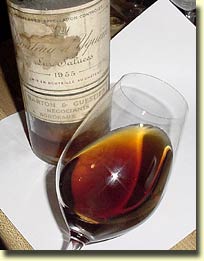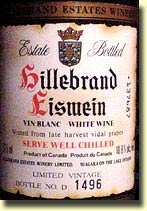|



 For
an appetizer I made some fennel pollen crusted salmon on truffled potato
gnocchi with a lobster stock beurre blanc (right). Pascal opened a Mondavi Fume
Blanc, which at the time was tough to consume after the Sauternes because
the acids lunged at the palate with vigor. However, it did its job and
worked well with the fish. For
an appetizer I made some fennel pollen crusted salmon on truffled potato
gnocchi with a lobster stock beurre blanc (right). Pascal opened a Mondavi Fume
Blanc, which at the time was tough to consume after the Sauternes because
the acids lunged at the palate with vigor. However, it did its job and
worked well with the fish.
For
our main course I roasted a rack of Albertan lamb (below). This stuff is just
amazing. The eye is huge, the marbling is rich and consequently when it
just reaches the degree of medium rare, the meat simply melts in your mouth. I reduced some lamb stock with thyme, shallots and red
wine. A few Morels tossed in
the pan (thank you Kim), crisp rosti potatoes and we were set. Set of
course except for the wine. I had pulled an 82 Lynch Bages and popped the
cork earlier on in the evening. Lamb, morels and Pauillac. Quite the
threesome, believe me!
 Neither
one of us is particularly into dessert, nor is making them my forte. To
finish our last glass of the Yquem, I had a round of Rougette de
Brigham,
a pasteurized cow’s milk cheese from Quebec. This artisan cheese is
macerated in apple brandy and aged for sixty days. Although not a lait cru
fromage, this was just brimming with flavour and the rich ripe apple
tones balanced beautifully with their counterparts in the Yquem. This truly was the flavour sensation of the night. Neither
one of us is particularly into dessert, nor is making them my forte. To
finish our last glass of the Yquem, I had a round of Rougette de
Brigham,
a pasteurized cow’s milk cheese from Quebec. This artisan cheese is
macerated in apple brandy and aged for sixty days. Although not a lait cru
fromage, this was just brimming with flavour and the rich ripe apple
tones balanced beautifully with their counterparts in the Yquem. This truly was the flavour sensation of the night.
1955 Chateau d’Yquem
Sauternes:
A visual treat, deep rich
yellow amber colour at the rim that reminded me of emergency room betadine. Orange, bronze, almost rusty brown tones at the base of the
bowl. A multidimensional nose featured freshly baked apple pie, raisins,
butterscotch, caramel and roasted hazelnut. It soon opened up  even more to
exhibit toffee, vanilla, UK treacle, ripe figs and a trace of licorice.
Amazing concentration of flavours on the palate, apricot, baked apple and
figs. The mouth coating texture was creamy, like that of a well-made
cappuccino. Quite spicy, it seemed dry at first but the sweetness came
through in the finish. Acidity was forward and kept it harmonious. The
finish was a monster and left flavours of dried apricots, dates and clover
honey around for a long time. even more to
exhibit toffee, vanilla, UK treacle, ripe figs and a trace of licorice.
Amazing concentration of flavours on the palate, apricot, baked apple and
figs. The mouth coating texture was creamy, like that of a well-made
cappuccino. Quite spicy, it seemed dry at first but the sweetness came
through in the finish. Acidity was forward and kept it harmonious. The
finish was a monster and left flavours of dried apricots, dates and clover
honey around for a long time.
The Foie Gras, or at
least the toast, blended nicely with the oak. It enhanced the fruit
slightly, especially the dried apricot, but the acids, now more
pronounced, become the principal match with the fatness of the liver.
Tasting much later with
the cheese, colour had remained the same but the nose was that of drying
fruits, baked spiced apples, cinnamon, dried apricot and caramel. It was
now in an unbelievable state, amazing level of viscosity in the mouth,
almost maple syrup in style and the finish was so rich, so cloying and
just plain fabulous. Nectar of the gods.
 1982 Chateau Lynch Bages
Pauillac:
In the decanter for about
three hours. Densely coloured deep red/garnet, showed no sign of over
maturing. Huge wafts of barnyard manure and aquarium were almost over
powering at the start. Mr. Flippy however, noted the nose as being quite
dull. The funk turned to softer tones of autumn leaves and mushroom. The
prominent aroma was cassis, closely followed by lead pencil, vanilla crème
Brulee, black fruits, coffee and eucalyptus.
The mouth was leathery, Pascal noted old leather jacket, and said
it was tight from the well integrated tannins, but the blackcurrant coulis
texture soon took over, along with plum, cherry and Arabian mint tea.
Finish was again truly a thrill, heaps of fruit, lively tannin, touch of
dill and basil. A thrill to drink. Those of you that have this in your
possession, enjoy it now or leave it for years to come, it will stand the
test of time. It was a gem. 1982 Chateau Lynch Bages
Pauillac:
In the decanter for about
three hours. Densely coloured deep red/garnet, showed no sign of over
maturing. Huge wafts of barnyard manure and aquarium were almost over
powering at the start. Mr. Flippy however, noted the nose as being quite
dull. The funk turned to softer tones of autumn leaves and mushroom. The
prominent aroma was cassis, closely followed by lead pencil, vanilla crème
Brulee, black fruits, coffee and eucalyptus.
The mouth was leathery, Pascal noted old leather jacket, and said
it was tight from the well integrated tannins, but the blackcurrant coulis
texture soon took over, along with plum, cherry and Arabian mint tea.
Finish was again truly a thrill, heaps of fruit, lively tannin, touch of
dill and basil. A thrill to drink. Those of you that have this in your
possession, enjoy it now or leave it for years to come, it will stand the
test of time. It was a gem.
1995 Ridge Paso Robles
Zinfandel:
Medium garnet/red colour,
lots of acid and noticeable alcohol up front. Lots of black and red berry
fruit, cooked plums, black pepper and damson. Nice Zin, touch dusty and
notes of chocolate on the finish.
 1986 Hillebrand Eiswein,
Niagara:
It is probable that no
one remembers what the make up of this wine really is. It was pre VQA
days, Canadian vintners could do as they chose. The label stated “made
from late harvest grapes” and even suggested, “drink well chilled.”
Dark brown in colour; I anticipated a nasty juice but was
surprised, fruit was still abound, with lime peel, citrus, orange
marmalade, coffee, roasted almond and molasses. Balance was lovely; it was
quite thick, viscous, and full of flavour and a surprising treat. 1986 Hillebrand Eiswein,
Niagara:
It is probable that no
one remembers what the make up of this wine really is. It was pre VQA
days, Canadian vintners could do as they chose. The label stated “made
from late harvest grapes” and even suggested, “drink well chilled.”
Dark brown in colour; I anticipated a nasty juice but was
surprised, fruit was still abound, with lime peel, citrus, orange
marmalade, coffee, roasted almond and molasses. Balance was lovely; it was
quite thick, viscous, and full of flavour and a surprising treat.
Cost of food - $100.00
Cost of wines - Who knows?
Cost of broken glass - $10.00
Cost of cleaning the
carpet - $55.00
Drinking
a legendary piece of history with one of your best friends - Priceless.
Cheers,
CZ
BACK TO PAGE
1
BACK TO
THE TOP
Alan
Kerr's Home Page and Main Index
|



 Neither
one of us is particularly into dessert, nor is making them my forte. To
finish our last glass of the Yquem, I had a round of Rougette de
Brigham,
a pasteurized cow’s milk cheese from Quebec. This artisan cheese is
macerated in apple brandy and aged for sixty days. Although not a lait cru
fromage, this was just brimming with flavour and the rich ripe apple
tones balanced beautifully with their counterparts in the Yquem. This truly was the flavour sensation of the night.
Neither
one of us is particularly into dessert, nor is making them my forte. To
finish our last glass of the Yquem, I had a round of Rougette de
Brigham,
a pasteurized cow’s milk cheese from Quebec. This artisan cheese is
macerated in apple brandy and aged for sixty days. Although not a lait cru
fromage, this was just brimming with flavour and the rich ripe apple
tones balanced beautifully with their counterparts in the Yquem. This truly was the flavour sensation of the night.  even more to
exhibit toffee, vanilla, UK treacle, ripe figs and a trace of licorice.
Amazing concentration of flavours on the palate, apricot, baked apple and
figs. The mouth coating texture was creamy, like that of a well-made
cappuccino. Quite spicy, it seemed dry at first but the sweetness came
through in the finish. Acidity was forward and kept it harmonious. The
finish was a monster and left flavours of dried apricots, dates and clover
honey around for a long time.
even more to
exhibit toffee, vanilla, UK treacle, ripe figs and a trace of licorice.
Amazing concentration of flavours on the palate, apricot, baked apple and
figs. The mouth coating texture was creamy, like that of a well-made
cappuccino. Quite spicy, it seemed dry at first but the sweetness came
through in the finish. Acidity was forward and kept it harmonious. The
finish was a monster and left flavours of dried apricots, dates and clover
honey around for a long time. 1982 Chateau Lynch Bages
1982 Chateau Lynch Bages 1986 Hillebrand Eiswein,
Niagara:
1986 Hillebrand Eiswein,
Niagara: